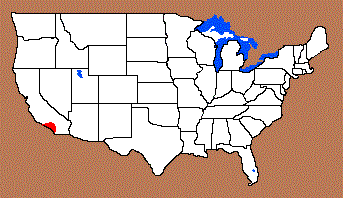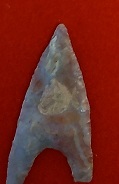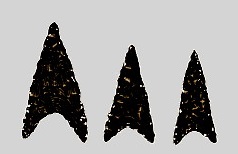Outline is Representative of Size and Shape:


Name Details:
Identified By: Lester A. Ross and John E. Finch
Named For: Type Site
Date Identified: 1970
Type Site: Buck Gully Canyon, Orange County California
Identified By: Lester A. Ross and John E. Finch
Named For: Type Site
Date Identified: 1970
Type Site: Buck Gully Canyon, Orange County California
Point Validity:
Provisional type
Ross is a distinguished archaeologist in California who is considered an expert on trade beads of the region. Finch worked for the California Fish and Game and was a vocational archaeologist. This type was discussed in a professional publication on a Horizon Site in Orange County. This type has not been discussed since that time and has no professional recognition as a true type. This is considered a provisional type.
Ross is a distinguished archaeologist in California who is considered an expert on trade beads of the region. Finch worked for the California Fish and Game and was a vocational archaeologist. This type was discussed in a professional publication on a Horizon Site in Orange County. This type has not been discussed since that time and has no professional recognition as a true type. This is considered a provisional type.
Buck Gully Triangle
Cluster: Western Triangle Cluster Description of Physical Characteristics and Flaking Pattern:
This is a small (1 to 1.25 inch) triangular point with an elliptical cross section. The overall shape may vary from an isosceles triangle (twice the height as width). The blade is most commonly excurvate, but many examples have straight blades and fewer have incurvate blades. The base are deeply concave with sharp basal auricles . This point has a random flaking pattern.
Size Measurements:
Total Length: 21 to 38 mm, Basal Width - 10 to 21 mm, Basal Concavity - 3 to 5 mm, Thickness - 3 to 5 mm
Total Length: 21 to 38 mm, Basal Width - 10 to 21 mm, Basal Concavity - 3 to 5 mm, Thickness - 3 to 5 mm
Commonly Utilized Material:
Additional Comments:
In literature (including pictured below) these points are commonly typed as Cottonwood points. The base of the Cottonwood Triangular points may vary to slightly concave, but these points have a deeply concave base. These points are similar in characteristic to the Bull Creek points of the Four Corners region.
Loyd Doty presents:
BUCK GULLY (Auriculated Triangular) – was named by California Fish and Game Biologist and avocational archaeologist John E. Fitch and formalized by archaeologist Lester A Ross, for examples recovered from the late Prehistoric Buck Gully #1 (4ORA190) and #2 (4ORA189) archaeology sites in Orange County, California. They are small (1” to 1 ½”) relatively crude, auriculated, triangular shaped projectiles. Blades expand from tips to bases which are the widest portion of this point type. They have moderately concaved bases with distinct ears at the corners. Distribution is within the Newport Beach region exclusively and they were in use during the late Prehistoric period.
Reference: Ross, Lester A. 1970, A Descriptive Site Report of a Late Prehistoric Horizon Site in Orange County, California. Pacific coast Archaeological Society Quarterly Vol. 6, (2/3):1-135.
In literature (including pictured below) these points are commonly typed as Cottonwood points. The base of the Cottonwood Triangular points may vary to slightly concave, but these points have a deeply concave base. These points are similar in characteristic to the Bull Creek points of the Four Corners region.
Loyd Doty presents:
BUCK GULLY (Auriculated Triangular) – was named by California Fish and Game Biologist and avocational archaeologist John E. Fitch and formalized by archaeologist Lester A Ross, for examples recovered from the late Prehistoric Buck Gully #1 (4ORA190) and #2 (4ORA189) archaeology sites in Orange County, California. They are small (1” to 1 ½”) relatively crude, auriculated, triangular shaped projectiles. Blades expand from tips to bases which are the widest portion of this point type. They have moderately concaved bases with distinct ears at the corners. Distribution is within the Newport Beach region exclusively and they were in use during the late Prehistoric period.
Reference: Ross, Lester A. 1970, A Descriptive Site Report of a Late Prehistoric Horizon Site in Orange County, California. Pacific coast Archaeological Society Quarterly Vol. 6, (2/3):1-135.
Distribution:

Distribution Comments:
This point is primarily found in the New Port region of southern California (Doty)
This point is primarily found in the New Port region of southern California (Doty)
Age / Periods:
Date: 1,400 - 650 B.P.
Cultural Period:Late Prehistoric / Developmental
Glacial Period: Vandal Minimum to Medieval
Warm
Culture:
Date: 1,400 - 650 B.P.
Cultural Period:Late Prehistoric / Developmental
Glacial Period: Vandal Minimum to Medieval
Warm
Culture:
Age Details:
This type is associated with fiber-tempered pottery.
This type is associated with fiber-tempered pottery.
Other points in this cluster / Related / Associated Points:
Aguaje, Bull Creek, Cohonina, Cottonwood Triangle, Canalino, Price Ranch, Sobaipuri
Aguaje, Bull Creek, Cohonina, Cottonwood Triangle, Canalino, Price Ranch, Sobaipuri




